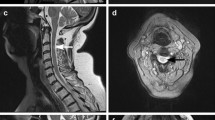Summary
In healthy subjects, 2 EMG responses of the thenar muscles can be distinguished, elicited by electrical stimulation of the median nerve during an isometric contraction: an early spinal response (M1) and a long latency response (LLR) (M2); earlier studies have shown that in patients with Huntington's chorea (HC) this late EMG response is missing. LLR were studied in nine subjects at risk out of three families with definite HC. In 6 of them, LLR was clearly asymmetrical or absent on one or both sides, while normal LLRs were seen in the rest of the subjects studied; LLR abnormalities found in clinically free members of HC families may assist in early diagnosis of individuals who may later develop symptoms and may help in genetic counselling.
Similar content being viewed by others
References
Claus D (1986) Long loop Reflexe — eine klinisch relevante Methode. Fortschr Neurol Psychiatr 54:35–41
Folstein SE, Leigh RJ, Parhard IM, Folstein MF (1986) The diagnosis of Huntington's disease. Neurology 36:1279–1283
Gusella JF, Wexler NS, Coneally PM, Naylor SL, Anderson MA, Tanzi RE, Watkins PC, Ottina K, Wallace MR, Sakaguchi AY, Young AB, Shoulson I, Bonilla E, Martin JB (1983) A polymorphic DNA marker genetically linked to Huntington's disease. Nature 306:234–238
Hayden MR, Martin WRW, Stoessel AJ, Clark C, Hollenberg S, Adam MJ, Ammann W, Harrop R, Rogers J, Ruth T, Sayre C, Pate BD (1986) Positron emission tomography in the early diagnosis of Huntington. Neurology 36:888–894
Josiassen RC, Shagass C, Mancall EL, Roemer RA (1982) Somatosensory evoked potentials in Huntington's disease. Electroencephalogr Clin Neurophysiol 54:483–493
Kuhl DE, Metter EJ, Riege WH, Markham CH (1984) Patterns of cerebral glucose utilisation in Parkinson's disease and Huntington' disease. Ann Neurol (Suppl) 15:119–125
Leblhuber F, Hoell K, Reisecker F, Gebetsberger B, Puehringer W, Trenkler J, Deisenhammer E (1989) Single photon emission computed tomography in Huntington's chorea. Psychiatr Res 29:337–339
Leblhuber F, Brucker B, Reisecker F, Trenkler J, Deisenhammer E (1989) Single photon emission computed tomography (SPECT) in probable Huntington's chorea (HC). J Neurol Transm [P-D Sect] 1:93–94
Noth J, Podoll K, Friedemann HH (1985) Long loop reflexes in small hand muscles studied in normal subjects and inpatients with Huntington's chorea. Brain 108:65–80
Oepen G (1986) Früherkennung der Huntington'schen Erkrankung durch neurophysiologische Untersuchungen, in: Die Huntington'sche Krankheit, H. Oepen (ed), Hippokrates Verlag, Stuttgart, pp 49–53
Oepen G, Doerr M, Thodon U (1981) Visual (VEP) and somatosensory (SSEP) evoked potentials in Huntington's chorea. Electroencephalogr Clin Neurophysiol 51:666–670
Author information
Authors and Affiliations
Rights and permissions
About this article
Cite this article
Leblhuber, F., Windhager, E., Reisecker, F. et al. Long latency EMG responses in early diagnosis of Huntington's chorea. Eur Arch Psychiatry Clin Nuerosci 241, 113–114 (1991). https://doi.org/10.1007/BF02191153
Received:
Issue Date:
DOI: https://doi.org/10.1007/BF02191153




